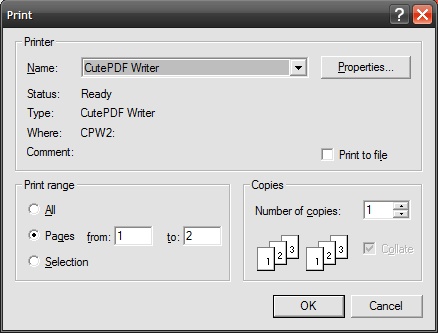I’ve worked with Adobe’s Flex platform now for several years, beginning with my Star Trek transporter simulator, a project I wrote for a Boston University course.
Now, my job at Transparent Language involves mostly FFA (Flash/Flex/AIR) development, and I enjoy the challenges of working in this fairly cutting-edge environment. This week, though, I was shocked by an apparent limitation in the mx.printing.FlexPrintJob class: It doesn’t return the operating system’s print dialog information to the Flex application. So, if I want to print, say, the first five pages of a document, it cannot normally be done. It’s all or nothing, regardless of what I specify in the OS print dialog.

The FlexPrintJob class wraps an older class, PrintJob. The primary difference is that PrintJob, designed for Flash, takes a Sprite as passed parameter to its addPage() function, whereas FlexPrintJob’s equivalent addObject() takes a UIObject. Fair enough.
But, what’s weird, is that the FlexPrintJob class contains a private PrintJob object, but it doesn’t expose any of the useful properties of that PrintJob object, except pageHeight and pageWidth. Want the printer name? The first and last pages in the page range the user has entered? The paper size? The orientation? Forget it! None of them are accessible.
Granted, most of these properties are AIR-only, but I’m working on an AIR project, and it would be darned useful for my users to be able to control their output, which can often run to many tens of pages, so I really need access to the properties of the “hidden” PrintJob object.
Thankfully, there’s a relatively easy solution. I can du plicate the FlexPrintJob class, and add accessors (getters) that will allow me to read the variables I need. Normally, I’d extend the class, but because the object and properties I need are private, I can’t even do that. I have to essentially clone the class, and add what I need to it. Thankfully, FlexPrintJob is part of Adobe’s code that has been open-sourced, so I can do this with impunity, and even distribute it.
So, I open the FlexPrintJob code, copy it to an empty class, rename it to FlexPrintJobExtended, and remove the reference to import Version.as, and add the following:
//--------------------------------------------------------------------------
//
// Additional accessors for PrintJob object
//
//--------------------------------------------------------------------------
public function get copies():int {
return printJob.copies;
}
public function get firstPage():int {
return printJob.firstPage;
}
public function get isColor():Boolean {
return printJob.isColor;
}
public function get jobName():String {
return printJob.jobName;
}
public function get lastPage():int {
return printJob.lastPage;
}
public function get maxPixelsPerInch():Number {
return printJob.maxPixelsPerInch;
}
public function get orientation():String {
return printJob.orientation;
}
public function get paperArea():Rectangle {
return printJob.paperArea;
}
public function get paperHeight():int {
return printJob.paperHeight;
}
public function get paperWidth():int {
return printJob.paperWidth;
}
public function get printableArea():Rectangle {
return printJob.printableArea;
}
public function get printer():String {
return printJob.printer;
}
Then, wherever I needed the FlexPrintJob class, I can then use my FlexPrintJobExtended class instead, and get access to all the glorious properties on the now-much-friendlier printJob object. Note that I’ve kept the properties read-only, by only writing getters. I did not envision any need to change the values: I only wanted to know what the user told the operating system.
The next obstacle is in the sample code provided for printing multipage documents. Begin by consulting the published examples for Printing with multipage PrintDataGrid controls. I’m not going to elaborate too much on this, merely illustrate how to get to the next step, printing multiple pages using the pages the user specified.
Looking at the section of the sample code marked with // The function to print the output, there are only a few things we need to change.
First, we need to change the FlexPrintJob instance created to use our new class:
// Create a FlexPrintJobExtended instance. var printJob:FlexPrintJobExtended = new FlexPrintJobExtended();
The user might not have chosen to start on page one, so we need to advance to the first page the user has chosen.
// Jump to the first specified page, not necessarily page 1.
while (errorPrintView.pageNumber < printJob.firstPage && errorPrintView.printGrid.validNextPage) {
thePrintView.printGrid.nextPage();
thePrintView.pageNumber++;
}
Then we modify the
while(true)
so that it won't go further than the number of pages the user has specified.
// Loop through the following code until all pages are queued. // If the user has chosen to print all pages, printJob.lastPage will be zero. while(printJob.lastPage == 0 || thePrintView.pageNumber <= printJob.lastPage)
Voila!
Feel free to download the code cited in this post: FlexPrintJobCode.zip.
If you find this to be useful, or find a better way to do it, let me know, by e-mailing "doug" at this domain. Cheers!

Hi Doug,
Just wanted to say thanks, this post gave me the idea to solve my issue.
Thanks a ton,
Ankit